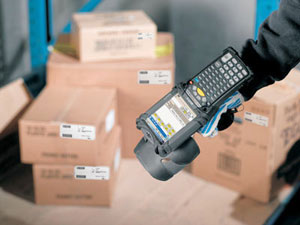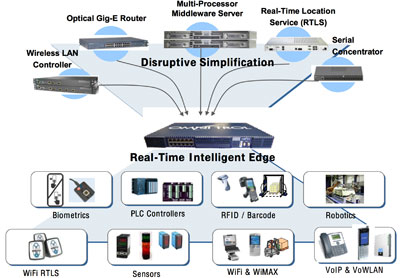How the advances in wireless, contactless and particularly RFID technologies can achieve benefits and be packaged and coupled with traditional and proven asset tracking solutions, specifically for addressing public safety requirements
by Joe Ireland, Omnitrol
Asset management is a critical function for public safety agencies. One that relies on internal, mostly manual, business processes, to protect, distribute, safeguard, and account for the tools that enforcement, emergency, judicial and other public safety agencies depend on for critical business operation. Technology is adopted when and where it makes sense, but is usually driven by on-demand processes.
These have been manual processes to date because there has been no viable alternative. Business process change and legacy technology adoption have provided only incremental efficiency and optimization improvements. Barcodes are used today and will continue to be used to provide significant classification and accountability services. However, new wireless technologies hold the promise for complementing existing technologies and creating the always-on, asset monitoring environments that public safety agencies require.
Asset tracking solutions offer public safety agencies the ability to streamline the administration of managing operational assets, reduce costs, and increase their tracking capabilities. Efficient asset tracking also offers:
- increased productivity with reduced paperwork;
- on-the-spot access to information about parts location, availability and possession;
- streamlined planning, reporting and logistical activities;
- fast manager approvals, without the manual paperwork;
- reduced errors in asset provisioning and deployment, ensuring that only approved personnel are issued equipment (for example, ensure that an Alcotester is not checked out only by an officer who is a breathalyzer technician);
- increased productivity by reducing the amount of time employees spend organizing and filling out sign-in and sign-out sheets;
- a validated chain of custody by passively detecting when and where assets are moved.
Automated process
 An automated asset management process manages the assignment and allocation of employee assets – assets that are closed loop assets, meaning they are checked out and returned for accountability. With technology advancements, organizations can now track these assets with wireless communication solutions that do not require manual intervention and can operate without a line of sight requirement. The asset tracking technology chosen must accommodate the specific tracking needs of an agencies’ assets such as when, where, how often, and at what range the assets will need to be tracked. Passive UHF (Ultra-High Frequency), EPC (Electronic Product Code) RFID is a wireless tracking technology which is becoming increasingly popular because of both its low cost for deployment and its long read ranges.
An automated asset management process manages the assignment and allocation of employee assets – assets that are closed loop assets, meaning they are checked out and returned for accountability. With technology advancements, organizations can now track these assets with wireless communication solutions that do not require manual intervention and can operate without a line of sight requirement. The asset tracking technology chosen must accommodate the specific tracking needs of an agencies’ assets such as when, where, how often, and at what range the assets will need to be tracked. Passive UHF (Ultra-High Frequency), EPC (Electronic Product Code) RFID is a wireless tracking technology which is becoming increasingly popular because of both its low cost for deployment and its long read ranges.
Adhesive-backed flexible RFID tags or more rugged hardened/encased RFID tags are affixed and associated with the assets to be tracked. Appropriate locations are then chosen as read points where RFID readers can read the RFID-tagged assets at ranges from 2 feet to beyond 30 feet, depending on the environment and type of tags and readers. These readers can be handheld readers, which do require manual intervention, or completely automated solutions with mobile readers or fixed readers. Fixed readers can be housed in turnkey and compact portal systems at points of ingress and egress. RFID is illustrated in this white paper as a preferred asset identification technology because of its low cost, and increasingly reduced deployment complexity. Alternative technologies like WiFi-based, RTLS (Real-Time Location System) and active RFID solutions can also be used, but each with its own cost, environmental and deployment characteristics.
A barcode solution can also be deployed to accommodate an existing infrastructure, but a barcode-only solution typically requires much more manual intervention and can be more prone to human error. However, barcode technology can provide an added layer of tracking that can complement an RFID-based solution. No matter what the information capture/management technology is – whether incorporating wireless, RFID, barcode technology or a combination of all three – another key component of any asset management solution is the asset tracking software. A real-time asset tracking solution must provide public safety agencies the flexibility to deploy a low risk, scalable, standalone, turnkey solution that minimizes the risk of complex backend Information Technology (IT) integration, while still delivering the power and flexibility that can seamlessly integrate and expand into the future.
The architecture and technology must be designed to enable public safety agencies to implement the
solution in a phased approach, accommodating the requirements for extending and adding new functionality. Additionally, an asset tracking system must integrate new asset tracking technologies like RFID, barcodes, mobile computing and scanning devices, WiFibased Real-Time Location Systems (RTLS), and other sensor-related technologies. Having these sensor based network devices on the work-floor is moving the legacy enterprise landscape towards a real-time intelligent services network at the edge. Having this edge intelligence and communication among readers, PLC controllers, mobile computers, printers, and other sensor devices is allowing business process workflows to be empowered at the edge and on the work-floor, where business operations happen, and away from legacy centralized database and ERP architectures of the past.
The asset management software provides complete management and data integration services for these intelligent edge devices, connectivity with existing back-end enterprise ERP systems, and operations management dealing with asset visibility, management dashboards, and reporting. This software, when combined with information capture/management technologies and products, provides an automated solution that can help public safety agencies to more efficiently manage their critical assets.
Registration and check-out
Public safety agency assets are registered into the system using RFID tags and optionally, in combination with barcode capable tags. The unique RFID and barcode tags are applied on the asset during registration. To maximize flexibility, handheld RFID readers can be used during the registration process. These portable RFID readers associate the asset’s serial and identification information with the unique identifier which is printed and written on the RFID tag. Registered assets and pedigree information can then be automatically tracked by the Real-Time RFID-enabled Asset Tracking system.
Assets are logged in or out with handheld RFID readers at the Check-In/Out Counter. In addition, an RFID Smart Portal reader serves as a validation point to ensure that assets are not removed without appropriate check-out association and authorization. The Portal reader also verifies that the employees left the room with only the checked-out assets assigned to them.
The asset check-out process follows the following general steps:
- The system identifies the employee requesting the asset using the staff’s unique Employee ID.
- The system automatically displays the pool the employee belongs to and all the assets that are currently checked out by the employee.
- The system validates if the employee is allowed to check-out the asset being requested, or if the asset would be a duplicate to an asset already checked out by the employee. If a duplicate is issued due to failure of the original then the check-out for the asset is appropriately annotated and the original asset is marked as requiring return with an automatic reminder if it is not returned within a specified time.
- The asset being checked-out is then identified using Motorola multimodal barcode and RFID handheld scanner that scans the asset tag.
- The asset identified is validated as not requiring maintenance or not having been serviced, etc. before it is processed for check-out.
- The asset is reconciled with the employee asset pool and validated to the allowed list of assets that can be checked-out by the employee, otherwise an alert is generated if the asset is not valid.
- A validated asset is added to the employees’ current list of checkedout assets.
- The asset is removed from the inventory pool and assigned to the employee checking-out the asset.
- The employee is now validated to use the asset and the asset is marked as checked-out to the employee.
- The employee leaves the room with the assigned assets. An alert is generated at the portal RFID reader if any assets are removed without proper authorization.
Check-in process
The check- in process for all registered assets initiates mandatory maintenance routines such as battery charging, inspection, etc. Assets assigned to employees and staff during the Asset Check-in Process are automatically logged and reconciled, utilizing the maintenance history for proactive maintenance of the asset. The Asset Check-in Process follows the following general steps:
- The system identifies the employee returning the asset using the staff’s unique Employee ID.
- The system automatically displays all the assets that are currently checked out by the employee.
- The asset being returned is identified using a handheld Motorola RFID/Barcode scanner that scans the asset tags.
- The asset is reconciled to the list of assets that were identified as checked-out by the employee; otherwise an alert is generated if the asset does not belong to the returning employee.
- The returned asset is removed from the employee list of checked-out assets 6. The asset is returned to the inventory pool with appropriate updates to the asset utilization history and pedigree.
- Any peculiarities associated with the utilization of an asset and the returning employee is highlighted, for example if the asset is being damaged consistently by the employee, or the asset is coming in for preventive maintenance ahead of schedule, etc.
- The system provides the asset utilization report and appropriate action to be taken for preventive maintenance.
- The asset is moved to the appropriate shelf depending on the recommended maintenance action required by the asset Any assets detected by the storage room portal RFID door reader that have not been checked-out in the system will trigger an alarm.
RFID
Any item that is a part of the work process but does not leave as part of a finished product is a candidate for intelligent asset management with RFID. RFID can help enterprises automatically track and secure these assets — with very little human intervention. This realtime technology takes asset management to the next level, providing unprecedented visibility, accuracy and security. With RFID, companies can automatically keep track of key assets as they move in and out of an area. With clear visibility into asset status and location, companies are more likely to perform regular and necessary maintenance — from software upgrades to lab equipment calibration.
Public safety deployment
These smart devices on the work-floor are changing the legacy enterprise landscape towards a real-time intelligent services network at the edge. The enterprise is fast evolving into a distributed, service-oriented corporation driven by real-time collaboration and innovation in business process, asset management and workflows where business operations happens at the edge on the workfloor away from legacy centralized database and ERP architectures of the past. This extended enterprise is enabling more service control and sophistication to operations management dealing with asset visibility and management dashboards.



